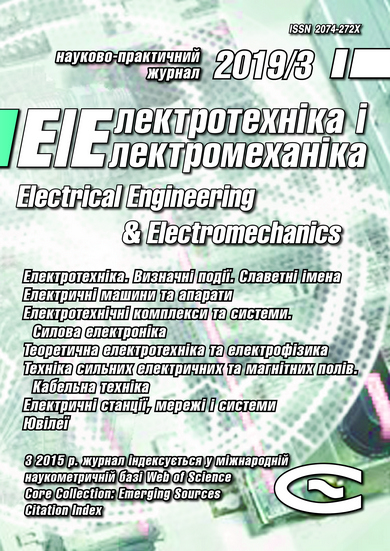TECHNOLOGICAL PARAMETERS OF THE COOLING MODE OF POLYMER INSULATION OF POWER CABLES
DOI:
https://doi.org/10.20998/2074-272X.2019.3.07Keywords:
cooling mode, polyethylene insulation, thermal equivalent circuit, discrete resistive equivalent circuit method, transient mode, nodal potentials method, system of linear algebraic equations, cooling bath lengthAbstract
Introduction. The cooling mode of polymer insulation after application to the extruder is one of the main factors determining cable performance. Theoretically, it is ideal to cool the insulation when the temperature of the cooling medium is equal to the melting point of the insulation material: in this case, the probability of formation of voids in the insulation is less. The cooling process is usually not subject to stringent requirements, since most insulating materials allow for quite sharp cooling. The exception is polyethylene, which requires gradual cooling. When the insulation is cooled in a cooling bath, the temperature decrease starts from the surface. In this regard, the cooling of the insulation of polyethylene is carried out in steps to a temperature at which the cooled extruded insulation will not be deformed or damaged on the receiving drum. Polyethylene is characterized by a large value of thermal expansion coefficient, the maximum value of which is in the temperature range (90-125) °C. As a result, there is an uneven reduction in the volume of the upper and inner insulation layers, especially for cables with a considerable insulation thickness. The rapid cooling of polyethylene leads to the formation of cracks, air inclusions both between the insulation and the conductive core, and in the layers located near the core. Purpose. The substantiation of the technological parameters of the cooling mode of power cables based on the calculation of the thermal equivalent circuit of a conductive core insulated with polyethylene in transient thermal mode. Methodology. The calculation of the temperature distribution in the thickness of extruded polyethylene insulation at different points in time, depending on the temperature of the cooling water, is made by the method of electrothermal analogies. There is a transition from the thermal equivalent circuit of power cables to the equivalent circuit of the discrete resistive equivalent circuit method, which is calculated using the nodal potential method. As a result of solving a three-diagonal system of linear algebraic equations by sweeping and finding at each discretization step (time step) thermal power fluxes in the branches of the thermal equivalent circuit, the temperature in the thermal capacitances determines the temperature in each insulation layer. Practical value. The duration of the transition process, corresponding to the achievement of the same temperature throughout the thickness of the insulation, can be considered as a criterion in determining the length of the cooling bath sections depending on the extrusion (reception) rate.References
Leonov V.M., Peshkov I.B., Ryazanov I.B., Kholodnyy S.D. Osnovy kabelnoy tehniki [Basics of cable technology]. Moscow, Akademiya Publ., 2006. 432 p. (Rus).
Kim V.S. Teoriya i praktika ekstruzii polimerov [Theory and practice of polymer extrusion]. Moscow, Khimiya, KolosS Publ., 2005. 568 p. (Rus).
Rauvendaal K. Ekstruziya polimerov [Polymer extrusion]. Saint Petersburg, Professiya Publ., 2006. 768 p. (Rus).
Rao Natti S., Shott Nik R. Tekhnologicheskie raschety v pererabotke plastmass [Technological calculations in plastics processing]. Saint Petersburg, Professiya Publ., 2013. 200 p. (Rus).
Khrenkov N.N. Calculation of the cooling modes of a moving cable. Cables and wires, 2018, no.1, pp. 20-25. (Rus).
Voznyuk V.T., Kravchenko Yu.O., Mikulyonok I.O. Increase cooling corrugated polymer pipes. Eastern-European Journal of Enterprise Technologies, 2011, vol.5, no.8(53). –pp. 46-50. (Rus).
Kazakov A.V., Petrenko A.A. Mathematical modeling of the polymer melt. Fundamental research, 2015, no.10(part 2), pp. 264-267. (Rus).
Carslaw H.S., Jaeger J.C. Conduction of heat solids. Second Ed. Clarendon Press, London, 2003. 510 p.
Bezprozvannych G.V., Naboka B.G. Matematicheskie modeli i metody rascheta elektroizoliatsionnykh konstruktsii [Mathematical models and methods of calculation of electrical designs]. Kharkiv, NTU «KhPI» Publ., 2012. 108 p. (Rus).
Demirchian K.S., Neiman L.R., Korovkin N.V., Chechurin V.L. Teoreticheskie osnovy elektrotekhniki: V 3-kh t. Uchebnik dlia vuzov [Theoretical bases of electrical engineering. In 3 vols.]. St. Petersburg, Piter Publ, 2003. 463 p. (Rus).
Kozdoba L.A. Elektricheskoe modelirovanie iavlenii teplo- i massoperenosa [Electrical modeling of heat and mass transfer phenomena]. Moscow, Energiya Publ., 1972. 296 p. (Rus).
Ametistov E.V. Teplo- i massoobmen. Teplotehnicheskiy eksperiment [Heat and mass transfer. Thermal engineering experiment]. Energoatomizdat Publ., 1982. 512 p. (Rus).
Downloads
Published
How to Cite
Issue
Section
License
Copyright (c) 2019 G. V. Bezprozvannych, I. A. Mirchuk, A. G. Kyessayev

This work is licensed under a Creative Commons Attribution-NonCommercial 4.0 International License.
Authors who publish with this journal agree to the following terms:
1. Authors retain copyright and grant the journal right of first publication with the work simultaneously licensed under a Creative Commons Attribution License that allows others to share the work with an acknowledgement of the work's authorship and initial publication in this journal.
2. Authors are able to enter into separate, additional contractual arrangements for the non-exclusive distribution of the journal's published version of the work (e.g., post it to an institutional repository or publish it in a book), with an acknowledgement of its initial publication in this journal.
3. Authors are permitted and encouraged to post their work online (e.g., in institutional repositories or on their website) prior to and during the submission process, as it can lead to productive exchanges, as well as earlier and greater citation of published work.





